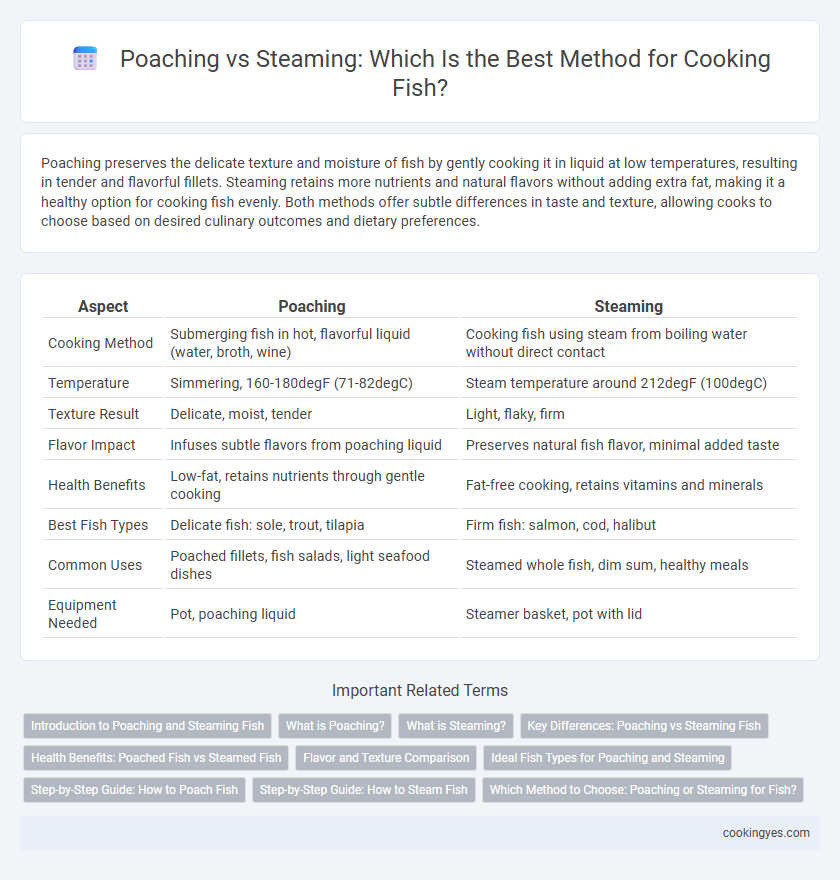Poaching preserves the delicate texture and moisture of fish by gently cooking it in liquid at low temperatures, resulting in tender and flavorful fillets. Steaming retains more nutrients and natural flavors without adding extra fat, making it a healthy option for cooking fish evenly. Both methods offer subtle differences in taste and texture, allowing cooks to choose based on desired culinary outcomes and dietary preferences.
Table of Comparison
| Aspect | Poaching | Steaming |
|---|---|---|
| Cooking Method | Submerging fish in hot, flavorful liquid (water, broth, wine) | Cooking fish using steam from boiling water without direct contact |
| Temperature | Simmering, 160-180degF (71-82degC) | Steam temperature around 212degF (100degC) |
| Texture Result | Delicate, moist, tender | Light, flaky, firm |
| Flavor Impact | Infuses subtle flavors from poaching liquid | Preserves natural fish flavor, minimal added taste |
| Health Benefits | Low-fat, retains nutrients through gentle cooking | Fat-free cooking, retains vitamins and minerals |
| Best Fish Types | Delicate fish: sole, trout, tilapia | Firm fish: salmon, cod, halibut |
| Common Uses | Poached fillets, fish salads, light seafood dishes | Steamed whole fish, dim sum, healthy meals |
| Equipment Needed | Pot, poaching liquid | Steamer basket, pot with lid |
Introduction to Poaching and Steaming Fish
Poaching fish involves gently cooking it in simmering liquid, preserving moisture and delicate flavors while maintaining a tender texture. Steaming fish uses hot vapor to cook, locking in nutrients and natural taste without adding fat or altering the fish's inherent qualities. Both methods are popular for healthy cooking, emphasizing subtle seasoning and preserving the fish's freshness and nutritional value.
What is Poaching?
Poaching is a gentle cooking method that involves submerging fish in a simmering liquid, such as water, broth, or wine, at a low temperature between 160degF and 180degF (71degC to 82degC). This technique helps retain the fish's moisture, delicate texture, and natural flavors without overcooking or drying it out. Poaching is especially suitable for delicate fish varieties like sole, cod, and salmon, resulting in tender and evenly cooked fillets.
What is Steaming?
Steaming fish involves cooking it by exposing it to steam vapor, preserving moisture and nutrients while enhancing the natural flavors without added fats. This method uses a steaming basket or rack above boiling water, ensuring even cooking and tender texture. Steaming is a healthier alternative to poaching, which submerges fish in water or broth, often risking nutrient loss due to direct contact with the liquid.
Key Differences: Poaching vs Steaming Fish
Poaching fish involves gently cooking it in a simmering liquid, typically flavored broth or water, which imparts subtle moisture and delicate taste while maintaining a tender texture. Steaming fish uses hot vapor to cook the fish without direct contact with water, preserving its natural flavors and nutrients while achieving a light, flaky consistency. Key differences include poaching's infusion of flavors from the cooking liquid and steaming's ability to retain the fish's pure essence and nutritional profile.
Health Benefits: Poached Fish vs Steamed Fish
Poaching fish preserves more nutrients due to lower cooking temperatures, resulting in a tender texture and reduced fat content. Steaming retains essential vitamins and minerals by minimizing nutrient loss into cooking water while maintaining the fish's natural moisture. Both methods are healthy options, but steaming slightly outperforms poaching in preserving antioxidants and omega-3 fatty acids.
Flavor and Texture Comparison
Poaching fish preserves a delicate, moist texture allowing subtle flavors to remain intact without overpowering the natural taste, resulting in tender and lightly flavored fillets. Steaming intensifies the fish's inherent flavor by gently cooking it in steam, which maintains firmness and prevents dryness, producing a slightly firmer texture with enhanced natural taste. Both methods retain nutrients effectively, but poaching offers a more nuanced flavor profile while steaming provides a clean, pure fish essence.
Ideal Fish Types for Poaching and Steaming
Delicate fish like sole, cod, and haddock are ideal for poaching due to their mild flavor and tender texture that benefits from gentle cooking in seasoned liquids. Steaming suits firmer fish such as salmon, halibut, and sea bass, preserving moisture while enhancing their natural flavors and flaky consistency. Both methods retain nutrients effectively, but selecting the right fish type maximizes taste and texture outcomes for each cooking style.
Step-by-Step Guide: How to Poach Fish
Poaching fish involves gently cooking it in simmering liquid such as water, broth, or wine at a temperature between 160degF and 180degF to maintain moisture and prevent overcooking. Start by selecting fresh, skin-on fish fillets, then prepare a flavorful poaching liquid with aromatics like lemon, herbs, and peppercorns; submerge the fish completely and cook for 8 to 10 minutes, depending on thickness, until it flakes easily with a fork. This method preserves delicate textures and nutrients better than steaming, making it ideal for lean fish like cod, sole, or tilapia.
Step-by-Step Guide: How to Steam Fish
Steaming fish preserves nutrients and enhances natural flavors by cooking it gently with moist heat. To steam fish, season the fillet with salt, pepper, and herbs, then place it on a heatproof plate inside a steamer basket over boiling water. Cover tightly and steam for 6-10 minutes, depending on thickness, until the fish is opaque and flakes easily with a fork.
Which Method to Choose: Poaching or Steaming for Fish?
Poaching fish ensures gentle cooking in flavored liquid, preserving delicate textures and infusing subtle tastes, ideal for lean or tender fish varieties. Steaming retains more nutrients and moisture by surrounding fish with hot vapor, producing a clean, natural flavor without added fats. Choose poaching when seeking infused flavors and tender results, and steaming when prioritizing health benefits and maintaining the fish's original taste.
Poaching vs Steaming for fish cooking methods Infographic

 cookingyes.com
cookingyes.com